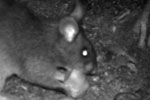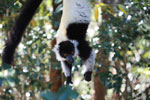
Jungle tree in Ujung Kulon National Park on the Indonesian island of Java. Photo by: Rhett A. Butler.
For decades scientists have been warning that if global society continues with “business-as-usual” practices the result will be a mass extinction of the world’s species, an extinction event some researchers say is already underway. However, the direct impacts of global biodiversity loss has been more difficult to compile. Now a new study in Nature finds that loss of plant biodiversity could cripple overall plant growth.
“Some people have assumed that biodiversity effects are relatively minor compared to other environmental stressors,” lead author David Hooper with Western Washington University said in a press release. “Our new results show that future loss of species has the potential to reduce plant production just as much as global warming and pollution.”
Looking at nearly 200 studies, the researchers compiled data on how primary production, i.e. plant growth, and decomposition are impacted by biodiversity loss in a wide-variety of ecosystems. According to the study, it depends on the magnitude of biodiversity loss. If up to 20 percent of the world’s plant species are lost, the impact on growth will be “negligible” says the study. However if 21-40 percent of the world’s plants vanish, primary production would be hit to the tune of 5-10 percent, and if half the world’s plant species vanish, primary production will fall by 13 percent. Some biologists have warned that species could be halved by the end of this century.
“Our analyses suggest that biodiversity loss in the 21st century could rank among the major drivers of ecosystem change,” the authors write, noting that a 13 percent loss in primary production compares to the impact of anthropogenic climate change on primary production.
While scientists found that the overall loss in decomposition was generally less than primary production, it was still worrisome. Moreover, the lopsided nature in which biodiversity loss impacts production over decomposition could hamper ecosystems’ ability to sequester carbon.
“Species loss ranks among the major drivers of primary production and decomposition—key processes involved in the carbon cycle and the provisioning of many ecosystem services,” the authors write.
The paper is buoyed by a number of recent studies which have shown that the more biodiverse an ecosystem, the more productive it is.
Complicating the situation is the fact that the world is not just facing mass extinction, but a wide variety of global environmental issues including climate change, nutrient pollution, and ozone loss.
“The biggest challenge looking forward is to predict the combined impacts of these environmental challenges to natural ecosystems and to society,” says co-author J. Emmett Duffy of the Virginia Institute of Marine Science.
CITATION: David U. Hooper, E. Carol Adair, Bradley J. Cardinale, Jarrett E. K. Byrnes, Bruce A. Hungate, Kristin L. Matulich, Andrew Gonzalez, J. Emmett Duffy, Lars Gamfeldt, and Mary I. O’Connor. A global synthesis reveals biodiversity loss as a major
driver of ecosystem change. Nature. 2012. doi:10.1038/nature11118.
Related articles
New meteorological theory argues that the world’s forests are rainmakers

(02/01/2012) New, radical theories in science often take time to be accepted, especially those that directly challenge longstanding ideas, contemporary policy or cultural norms. The fact that the Earth revolves around the sun, and not vice-versa, took centuries to gain widespread scientific and public acceptance. While Darwin’s theory of evolution was quickly grasped by biologists, portions of the public today, especially in places like the U.S., still disbelieve. Currently, the near total consensus by climatologists that human activities are warming the Earth continues to be challenged by outsiders. Whether or not the biotic pump theory will one day fall into this grouping remains to be seen. First published in 2007 by two Russian physicists, Victor Gorshkov and Anastassia Makarieva, the still little-known biotic pump theory postulates that forests are the driving force behind precipitation over land masses.
Protecting original wetlands far preferable to restoration
(01/26/2012) Even after 100 years have passed a restored wetland may not reach the state of its former glory. A new study in the open access journal PLoS Biology finds that restored wetlands may take centuries to recover the biodiversity and carbon sequestration of original wetlands, if they ever do. The study questions laws, such as in the U.S., which allow the destruction of an original wetland so long as a similar wetland is restored elsewhere.
Recognizing value of nature could boost income for the world’s poor
(01/20/2012) The rural poor would substantially boost their income if the ecological services of the ecosystems they steward were valued and compensated by the rest of the world, claims a new study published in the journal Bioscience.
Giant rat plays big ecological role in dispersing seeds

(11/16/2011) Rats are rarely thought of as heroes. In fact, in many parts of the world they are despised, while in others they serve largely as food. But, scientists are now discovering that many tropical forest rodents, including rats, serve as heroic seed dispersers, i.e. eating fruits and nuts, and carrying seeds far from the parent tree, giving a chance to a new sapling. While this has been documented with tropical rodents in South America like agoutis and acouchis, a new study in Biotropica documents the first successful seed dispersal by an African rodent: the Kivu giant pouched rat (Cricetomys kivuensis), one of four species of giant African rats.
Critically Endangered lemurs disperse seeds, store carbon

(11/13/2011) Many tropical plants depend on other species to carry their progeny far-and-wide. Scientists are just beginning to unravel this phenomenon, known as seed dispersal, which is instrumental in supporting the diversity and richness of tropical forests. Researchers have identified a number of animal seed dispersers including birds, rodents, monkeys, elephants, and even fish. Now a new study in the Journal of Tropical Ecology adds another seed disperser to that list: the Critically Endangered black-and-white ruffed lemur (Varecia variegata). Capable of dispersing big tree species, the black-and-white ruffed lemur may even play a big role in carbon sequestration.
Atlantic Forest stores less carbon due to drastic fragmentation
(09/26/2011) The Atlantic Forest in Brazil is one of the most fragmented and damaged forests in the world. Currently around 12 percent of the forest survives, with much of it in small fragments, many less than 100 hectares. A new study in mongabay.com’s open-access journal Tropical Conservation Science finds that the bloodied nature of the Atlantic Forest impacts its capacity to sequester carbon. The study found that 92 percent of the forest stored only half its potential carbon due to fragmentation and edge-effects, which includes damage due to winds and exposure to drought.
(08/01/2011) New research in the Journal of Applied Ecology shows that ground beetles help farmers in the UK by devouring weed seeds before they can sprout. The researchers say the study finds another proof of how biodiversity—the multitude of species on Earth—provides ‘free’ ecosystem services for people.